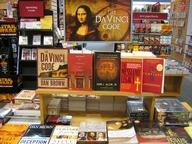Quiz Answer Key and Fun Facts
1. Critics might argue that Dan Brown's novel "The Da Vinci Code" is the latest in a long series of insults, physical and figurative, heaped upon Leonardo da Vinci's famous wall painting, "The Last Supper". In keeping with the title of this quiz, what happened to the painting in 1652?
2. As the title of Dan Brown's "The Da Vinci Code" implies, the people of Leonardo's home town would have known him by his last name, Da Vinci.
3. Dan Brown's novel "The Da Vinci Code" makes much of a figure in Leonardo's painting "The Last Supper" being the female follower of Jesus named Mary Magdalene. According to Leonardo's own notebooks and sketches, who is the person immediately to the right of Jesus in the painting?
4. An authoritative character in "The Da Vinci Code" by Dan Brown, stated that, at the Council of Nicea in 325 A.D., "Constantine collated an entirely new Bible, containing only books that speak of Jesus as divine." Is this statement true or false?
5. Dan Brown's novel "The Da Vinci Code" claims that Leonardo da Vinci's painting popularly called "The Mona Lisa" got its name from an anagram of the name of the Egyptian fertility god Amon and a variation of the name for the fertility goddess Isis. What is the painting called in Leonardo's native Italy?
6. Dan Brown's character Robert Langdon in "The Da Vinci Code" states that the planet Venus traces a "perfect pentacle" (a five-pointed star) as it crosses the sky, and he claims that the four-year cycle of the Olympic Games is based on "half-cycles" of the journey of Venus through the heavens. To which mighty Greek god or goddess were the original Olympic games devoted?
7. Dan Brown bases much of the theme of his novel on "facts" in a book by Michael Baigent, Henry Lincoln, and Richard Leigh, published in 1982 and titled "Holy Blood Holy Grail". What are the scholarly credentials of the writers of Brown's "historical" source for "The Da Vinci Code"?
8. The first medieval King Arthur stories about the Holy Grail, written by Chretien de Troyes around 1175 A.D., use the word "grael" alone for a mysterious serving vessel, without explaining its symbolism or describing it in detail. The word "san" ("holy") came to be used with the word "grael" to indicate its sacredness and to transform it into a Christian symbol. What etymology does Dan Brown give for the term "Sangrael" in his novel "The Da Vinci Code"?
9. Dan Brown, in the final chapters of "The Da Vinci Code", reveals his thesis that the "Sangrael" that carries the "royal blood" of Christ is actually the womb of Mary Magdalene, the female vessel who was the wife of Jesus. In most Christian theology based on the New Testament, to what or whom does the phrase the "Bride of Christ" symbolically refer?
10. Enter the door into "The Collegiate Church of St. Matthew the Apostle" - built before 1480 as a family chapel by order of William Sinclair, first Earl of Caithness in Scotland - and you will find fascinating stonework carvings, but no secret underground chamber or grooves in the floor in the shape of a Star of David and no connections to Leonardo Da Vinci or Mary Magdalene as implied in Dan Brown's "The Da Vinci Code". In what real place are you standing?
Source: Author
nannywoo
This quiz was reviewed by FunTrivia editor
looney_tunes before going online.
Any errors found in FunTrivia content are routinely corrected through our feedback system.

